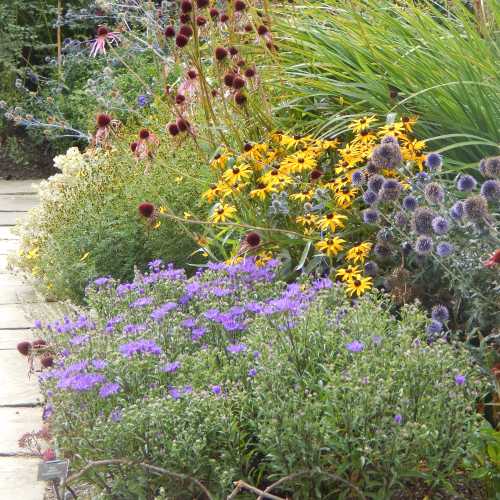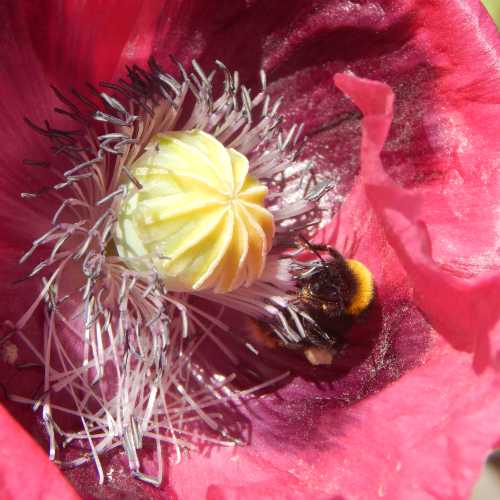Plants to Attract Bees:
Shrubs, Hedgerows, and Trees
Updated: 8 December 2023
If you are wanting to attract bees into your garden, it's easy to forget about
trees, shrubs and hedgerows! Yet they provide a number of benefits relating to food and shelter for different species.
Why are trees, shrubs, and hedgerows valuable for bees?
Firstly, trees, hedgerows and shrubs can provide nesting opportunities for bees, which may make their nests in abandoned rodent holes found at the base of a shrub, or in crevices and holes within the bark of a tree trunk, or hollow twigs.
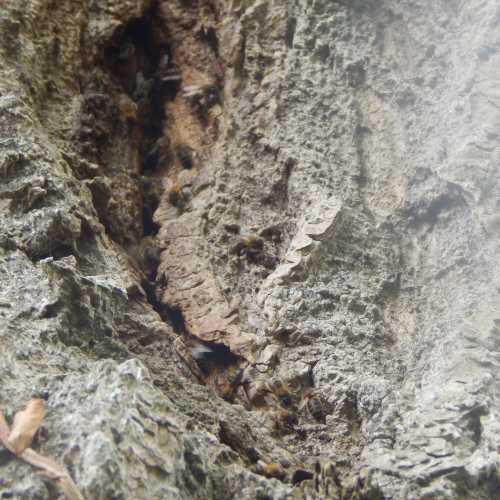 Wild honey bee nest in tree trunk.
Wild honey bee nest in tree trunk.Secondly, they also provide excellent
foraging potential. A
decent sized shrub may be densely covered in nectar and pollen-rich
flowers.
This means foraging is
efficient, requiring less energy for the bees to fly about in search of
further
sources of food.
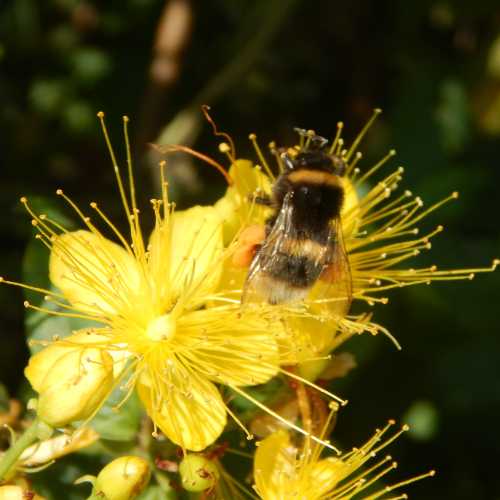 Bumble bee on Hypericum bush.
Bumble bee on Hypericum bush.Even at the end of the flowering season, trees and shrubs have their value for bees
Even the hollow stems of shrubs can be useful to bees. Tiny solitary bees may overwinter or make nests in them.
For example, the tiny harebell carpenter bee, Chelostoma campanularum is only about 6 or 7mm in size and can easily be mistaken for a little black fly. It may create its nests in hollow stems of plants (or even in woodworm and beetle holes).
Bumble bees meanwhile,
may take cover in piles of fallen leaves.
The lesson is, please take
care when tidying your garden. Perhaps hollow shrub stems could be
collected and placed in a corner of the garden or behind the shed rather than burned, for
example.
 Bumble bee on Escallonia.
Bumble bee on Escallonia.Furthermore, as the bees pollinate the flowers, the flowers develop into fruits (such as apples, plums, cherries or pears), berries (raspberry, blackberry and many more) and nuts (like hazelnut), which are then enjoyed by humans, but also birds and small mammals.
Animals and birds may additionally enjoy hips and waxy berries like cotoneaster and holly thanks to pollination of their flowers by bees and other insects.
For me, there is nothing better than to watch wildlife in the garden - it provides entertainment, wonder, and sometimes a bit of natural garden "pest control".
Tip
Remember that it may also
be possible to underplant your trees and shrubs with yet more plants to
attract to bees, such as crocus, snowdrops, Snake's head fritillary, bluebells, and other
flower bulbs.
LATE WINTER - SPRING shrubs, hedgerows and trees for bees:
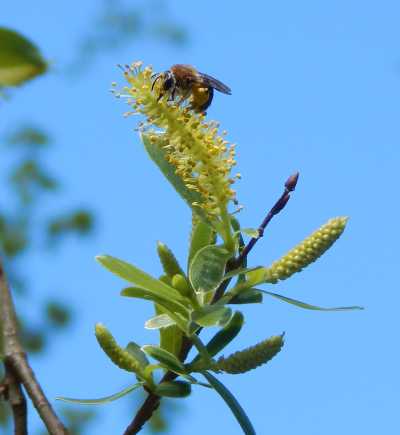 Orange-tailed mining bee on willow catkin.
Orange-tailed mining bee on willow catkin.Ceanothus
Mahonia
Acacia (A. dealbata & A. longifolia)
Willow (Salix) - provide an early source of pollen
Manuka (Leptospermum)
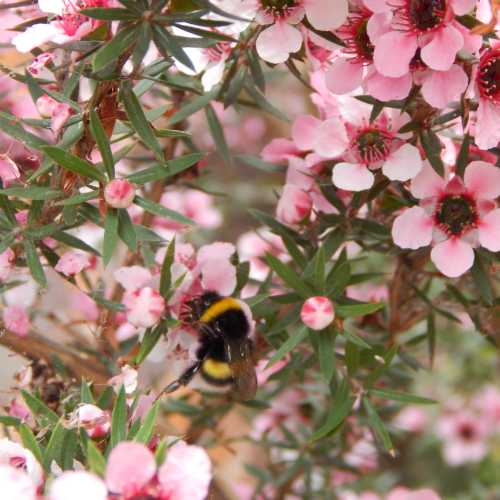 Bumble bee on manuka bush.
Bumble bee on manuka bush.Heathers
Flowering Currant (Ribes)
Broom (Genista)
Alder (A. cordata; A.incana; A. glutinosa)
Blackthorn (Prunus spinosa)
Rosemary (Rosemarinus officinalis)
Hazels - Corylus (C. avellana, C. maxima) great trees for bees, especially for pollen
Bleeding Heart (Dicentra)
Winter Honeysuckle climber great for hedgerows (Lonicera fragrantissima and Lonicera purpussii).
SPRING - SUMMER shrubs, hedgerows and trees for bees:
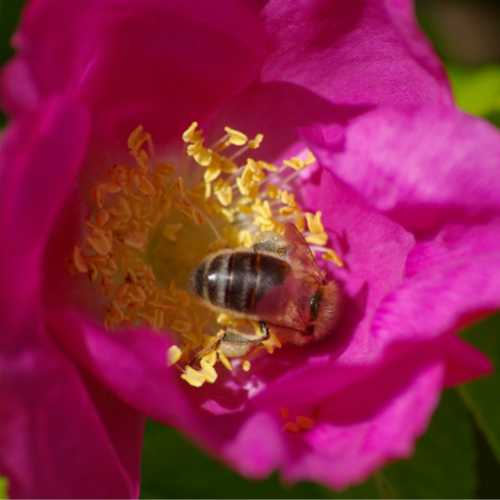 Honey bee foraging on Rosa rugosa.
Honey bee foraging on Rosa rugosa.Wild roses and Rosa rugosa
Wild cherry (Prunus avium)
Sour cherry (Prunus cerasus)
Joshino cherry (Prunus xyeodensis)
Horse chestnut
Escallonia
Hawthorn
Hebe
Bird cherry (Prunus padus)
Apples
Pears
Mountain ash (Sorbus)
Hollies (Ilex)
Sallows
Guelder rose (Viburnum opulus)
Sloes
Cotoneaster - various species
American lilac (Ceanothus)
June Berry (Snowy mespilus)
Pieris
Whitebeam
Sycamore
Wayfaring tree (Viburnum lantana)
Brambles
SUMMER - AUTUMN shrubs, hedgerows and trees for bees:
Hydrangea - certain species.
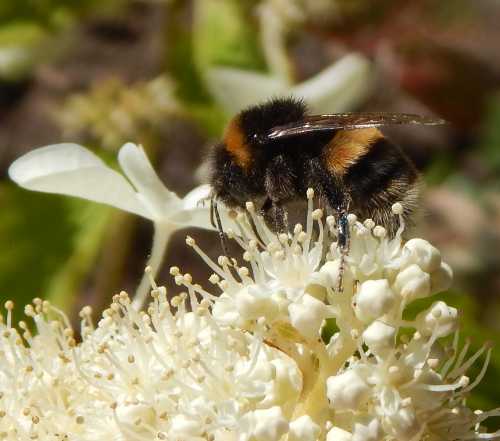 Bumble bee on Hydrangea paniculata.
Bumble bee on Hydrangea paniculata.
Common Privet (Ligustrum vulgare)
Eucalyptus
Lime trees - but select careful, because some lime trees are toxic for, or have narcotic effects on bees
Whitebeam
Sycamore
Hypericum
AUTUMN - WINTER shrubs, hedgerows and trees for bees
Read my page Winter Flowering Shrubs For Bees
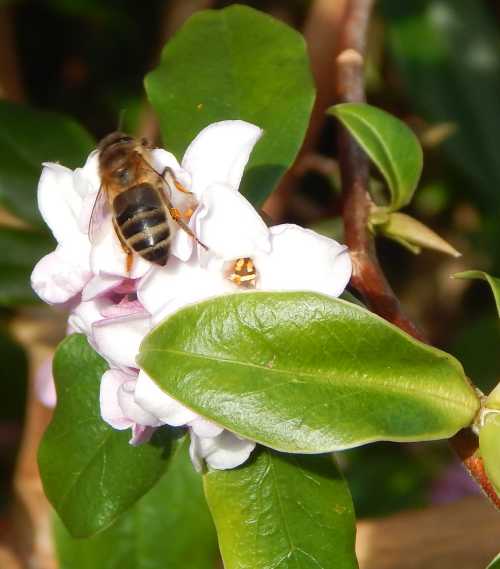
Daphne bholua Jaqueline Postill
Chinese Euodia (Tetradium daniellii hupehensis)
Ivy - Hedera helix
Strawberry Tree (Arbutus unedo)
Mahonia - Oregon grape
Sweet box - Sarcococca confusa
FREE PDF DOWNLOAD:
Planning And Planting A Bee Friendly Garden
